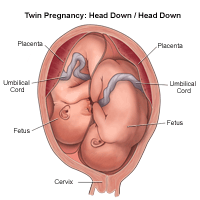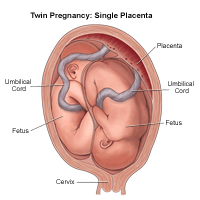Overview of Multiple Pregnancy
What is multiple pregnancy?
Multiple pregnancy is a pregnancy with two or more fetuses. Names for these include the following:
-
Twins--two fetuses
-
Triplets--three fetuses
-
Quadruplets--four fetuses
-
Quintuplets--five fetuses
-
Sextuplets--six fetuses
-
Septuplets--seven fetuses
While multiples account for only a small percentage of all births (about 3 percent), the multiple birth rate is rising. According to the National Center for Health Statistics, the twin birth rate has risen 70 percent since 1980, and is currently 32.6 per 1,000 live births. The birth rate for triplets and other higher order multiples rose dramatically but has slowed since 1998.
What causes multiple pregnancy?
There are many factors related to having a multiple pregnancy. Naturally occurring factors include the following:
-
Heredity
A family history of multiple pregnancy increases the chances of having twins.
-
Older age
Women over 30 have a greater chance of multiple conception. Many women today are delaying childbearing until later in life, and may have twins as a result.
-
High parity
Having one or more previous pregnancies, especially a multiple pregnancy, increases the chances of having multiples.
-
Race
African-American women are more likely to have twins than any other race. Asian and Native Americans have the lowest twinning rates. Caucasian women, especially those over age 35, have the highest rate of higher-order multiple births (triplets or more).
Other factors that have greatly increased the multiple birth rate in recent years include reproductive technologies, including the following:
-
Ovulation-stimulating medications, such as clomiphene citrate and follicle stimulating hormone (FSH) help produce many eggs, which, if fertilized, can result in multiple babies.
How does multiple pregnancy occur?
Multiple pregnancy usually occurs when more than one egg is fertilized and implants in the uterus. This is called fraternal twinning and can produce boys, girls, or a combination of both. Fraternal multiples are simply siblings conceived at the same time. However, just as siblings often look alike, fraternal multiples may look very similar. Fraternal multiples each have a separate placenta and amniotic sac.
 |
| Click Image to Enlarge |
Sometimes, one egg is fertilized and then divides into two or more embryos. This is called identical twinning and produces all boys, or all girls. Identical multiples are genetically identical, and usually look so much alike that even parents have a hard time telling them apart. However, these children have different personalities and are distinct individuals. Identical multiples may have individual placentas and amniotic sacs, but most share a placenta with separate sacs. Rarely, identical twins share one placenta and a single amniotic sac.
 |
| Click Image to Enlarge |